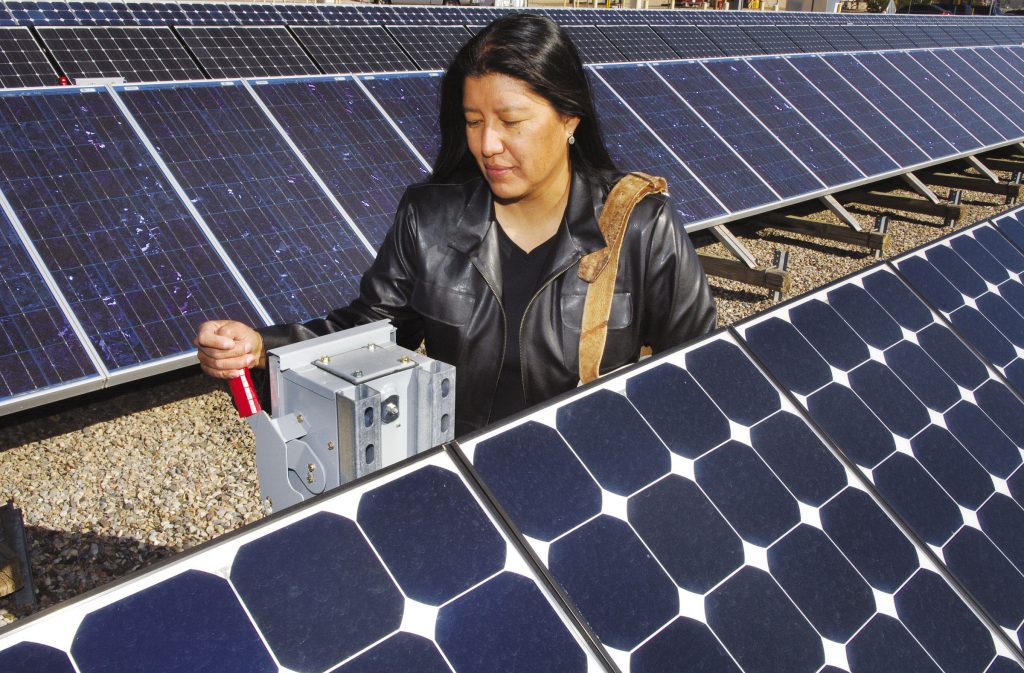
Download 300dpi JPEG image, “debby-tewa.jpg,” 924K (Media are welcome to download/publish this image with related news stories.)
ALBUQUERQUE, N.M. — Debby Tewa spent her first 10 years living without electricity, water, or a telephone in a three-room stone house in an isolated area of the Hopi Reservation in Arizona.
Today, as a contractor to the Sandia National Laboratories Sandia Tribal Energy Program, she provides technical advice about maintaining photovoltaic (PV) units to people on Indian reservations who live remotely like she did. For many, it’s the first time they’ve had electricity in their homes.
“I can identify with the people I’m helping,” Tewa says. “Many live the way I grew up, and I fully appreciate their excitement in having electricity and light at night.”
As part of Tewa’s job, she and program director Sandra Begay-Campbell offer technical advice to tribal governments, which receive Department of Energy (DOE) tribal energy grants. Her work also includes teaching Native Americans how to use and maintain photovoltaic units, supporting project management plans, and helping people learn from each other about their photovoltaic systems. In addition, she is enhancing DOE’s PV Reliability database with off-grid system information that includes Navajo PV systems maintenance data.
Tewa and Begay-Campbell work closely with the Navajo Nation with which Sandia signed a memorandum of understanding in 2000 to encourage further collaboration. The Navajo Utility Authority, through DOE funding, has installed photovoltaic units at more than 300 homes on the reservation since 1993.
“There is still a long way to go,” Tewa says. “It’s estimated there are 18,000 families in the Navajo Nation without electricity.”
The reason there are so many, she adds, is that many Navajos live at remote sites, like she did as a youth, and it is prohibitively expensive to string electricity lines to those areas. The cost of expanding the gridline is about $27,000 per mile. Many Navajos make do with kerosene, wood, and coal.
Tewa lived with her grandmother in the unelectrified house through the fifth grade. Then she moved to Tuba City, Ariz., to live with her parents where they had a telephone, electricity, and water.
After graduating at the top of her class from Sherman Indian High School in Riverside, Calif., she attended Northern Arizona University where she spent two years but never got a degree. She decided to take the nontraditional path and went to a trade school to study to become an electrician.
After obtaining her electrical theory and application certification, she worked briefly as an electrician for the Gila River Indian Reservation south of Phoenix. In 1987 she joined NativeSUN, a Hopi-managed nonprofit organization that installs PV units at homes in remote areas off the grid.
She spent 11 years there, first as an electrician and later as a program manager, bringing electric light to people who never had it before.
One of the people she helped with her first photovoltaic system was her aunt, who quickly adapted to the new technology.
“She’s had her system for 12 years now and just changed the battery for the first time,” Tewa says. “She’s happy with the system.”
Tewa spoke with her customers in their Hopi language and helped them understand what was involved in having a photovoltaic unit.
After 11 years, she went back to school and earned a BS degree in Applied Indigenous Studies with a minor in Environmental Science. Begay-Campbell recruited her as a student intern three years ago to assist her with the tribal energy work.
Her current job has given her some interesting experiences, she says. For example, she’s been working with the Ramona Band of Cahuilla Indians in Southern California. They are developing an ecotourism business that brings ecologists to learn about the local flora and fauna. They were not hooked up to the electric grid. Tewa works with their electrical contractor to set up a hybrid system for their business that consists of a small wind unit, photovoltaic system, and a back-up diesel generator.
She also gives photovoltaic workshops to women, most recently in August at the American Solar Energy Society Conference in Florida. As part of the workshop, the 20 participants installed a photovoltaic unit at an elementary school in Orlando, Fla. Helping with instruction were Marlene Brown of Sandia and Lori Stone of Solar Energy International.
Soon Tewa will be back working with her native Hopi people. The tribe recently received a DOE grant to develop a wind turbine program.
“I’ll be offering them technical assistance as a part of my job with Sandia,” she says. “It’ll be good helping people at home again.”